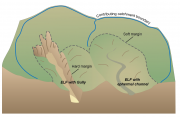NESP TWQ Round 5 - Project 5.10 – Development and application of automated tools for high resolution gully mapping and classification from LiDAR data
Accurately mapping gullies at high resolution and quantifying their key attributes is the critical first step in the process of prioritising and designing rehabilitation solutions. At least 40% of the accelerated erosion that is contributing to poor water quality in the Great Barrier Reef (GBR) Lagoon is sourced from gully erosion, demanding effective management and rehabilitation of these features. Current gully maps across the GBR are low resolution and overly simple, providing no differentiation between gully type. Airborne Light Detection And Ranging (LiDAR) is now widely recognised as being the best way to accurately map gullies at a landscape scale at a suitable resolution for management planning. Given the large volume of LiDAR data now becoming available, this project developed and applied automated tools to enable the location of gullies to be extracted from LiDAR Digital Elevation Models (DEMs), along with key attributes of the gullies enabling them to be grouped into classes of similar gully types to aid prioritisation, management and catchment modelling.
Find NESP TWQ 5.10 project reports, fact sheets and presentations on the NESP TWQ Hub website.
Datasets

This dataset contains maps of alluvial and hillslope gullies across four large blocks of lidar covering portions of the Burdekin, Fitzroy, and Normanby Catchments. The gully polygons were generated using methods developed in the NESP 5.10 project for the extraction of gullies from lidar. Lidar is detailed topographic data collected from aircraft using an airborne laser scanning system.





